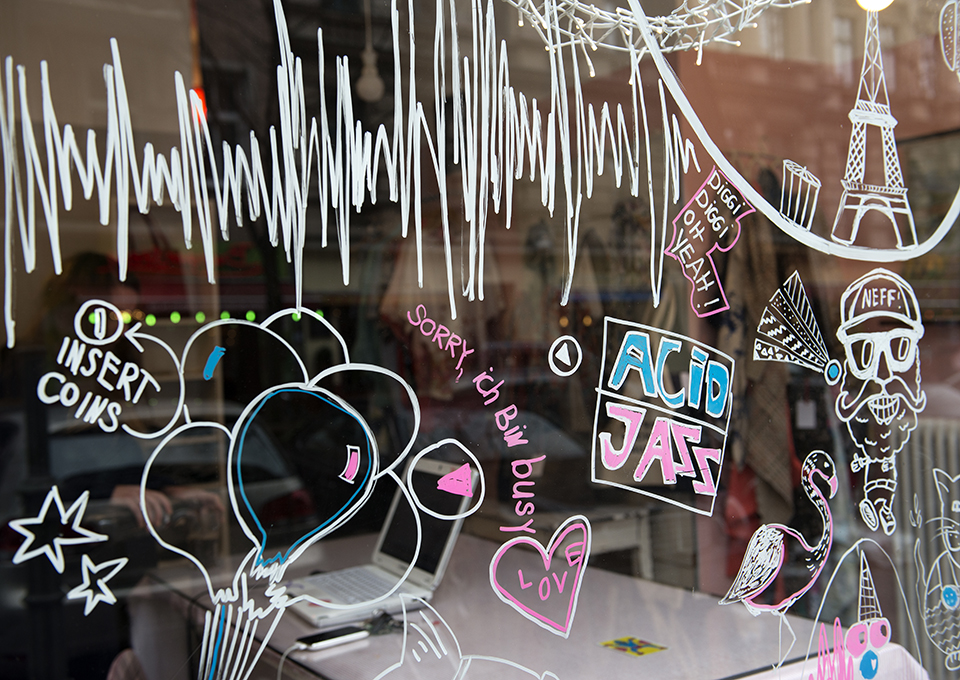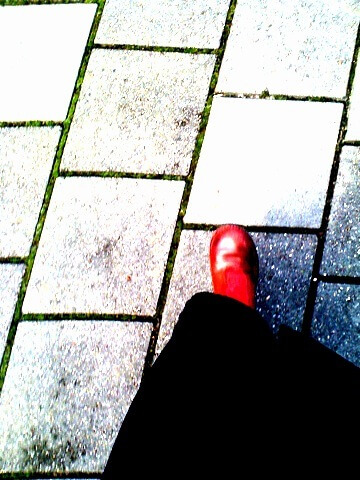Kreuzkölln. Don’t look for it on the map, because it isn’t there. What you will find is Neukölln. And then there is Kreuzberg pinched between former GDR boroughs. And than there is Friedrichshain, a borough in east Berlin full of students, punk rockers and artists. And right where those boroughs touch, is the fictional Kreuzkölln. The alternative of artists and freedom lovers in Berlin.
Kreuzkölln hotspots:
1. Graffiti tour
Berlin is city with a lot of graffiti and Street Art. Some of the artworks, like the East Side Gallery you can go see by yourself just fine. But it is more fun to go on a tour with a graffiti artist who shows you the impressive works of people like El Bocho.
His cartoon like women populate the walls of Berlin or Various and Gould who use their long posters to draw attention to the fate of the underdog. The Hidden Path offers great tours in this part of town.
2. Café Tasso
One of our favorite Kreuzkölln hotspots is café Tasso. This café and secondhand bookstore is situated on the long Frankfurter Allee. It is a cosy island hidden between huge apartment blocks. Once this was the boulevard where the palaces for the proletarians were supposed to be built. Tasso brings everything back to normal proportions.
It is a cafe, a restaurant, an antiquarian and a second hand bookstore. Lectures and concerts take place. The cafe is managed by mentally disabled people with some help of the able ones. Oh and everything is very ecological! Metro U5 Frankfurter Tor
3. Hüttenpalast
Silke Lorenzen, is Berliner at heart. She once had the fabulous idea to drag some caravans, huts and the vestibule of a church into an former factory of vacuum cleaners. She started an indoor camping in the middle of Berlin.
Kreuzkölln wasn’t born yet and Neukölln was a bleak district where no tourist would ever come. Her Hüttenpalast now is a hit and a Kreuzkólln hotspot. It offers nice corners to sit, bookcases all over and a tree growing fresh croissants in the morning. Our tip: for when you are in a romantic mood go for the silver gypsy caravan.
4. Swimming
Berlin has some very special swimming pools. For example Stadtbad Neukölln from 1914, inspired by ancient Greek architecture. Here you can swim between high columns and pretend you are in ancient Greece between philosophers.
Rather something more modern? How about Badeschiff, a pool in the river Spree that in the summer is being turned into a sandy beach with deckchairs. Until some time ago it would be covered in the winters you could swim and enjoy the stars and the citylights. Stadtbad is to be found at Ganghoferstraße 3, 12043 Berlin – Neukölln
5. Paleolithic food
I beg your pardon? Indeed! Berlin is one of the few places in the world where you can actually have paleolithic food. The idea is that food of the prehistoric man must have been way more healthy. No cereals, no milk products and only meat without additives.
What’s on the menu? Well a hunters dish made of cornbread, meat and vegetables. And no, you don’t have to swing your club and go off hunting. You can just enjoy a good glass of wine on a candle lit table.
Restaurant Sauvage hit it off in 2011 and became a Kreuzkölln hotspot, however after a few prosperous years they closed without further notice.
But we found Restaurnant Herz & Niere (heart & kidneys) to be a good alternative. If you do eat meat, then you should eat everything the animal has to offer is their philosophy.
6. Cross country skiing at Tempelhof
Once Tempelhofer Field was where the military parades were held and it was the picnic area for families. The place where in 1908 the German aviation was born. But it is the Second World War with which most people associate this enormous complex because of the megalomaniac plans of the Nazi’s. Just walking around the 1,5 kilometers long building takes you an hour.
Some details: it contains 9.000 offices, conference rooms, casino’s, halls, streets, an underground railway, bunkers and shelters. All fits just fine. In the winter the area is being used for cross country skiing as soon as there is some snow. There are many different tours.
7. Dancing on the RAW-site
On the RAW-site, a former factory site, a large multicultural complex arose. Until 1991 it was the maintenance area of the German railway. After the fall of the Berlin wall, it was squatted. Now there are five nightclubs and there is a skate-hall. It became one of the true Kreuzkölln hotspots.
Techno beats of all kinds are to be enjoyed. And strangely enough, between the squatted buildings covered in graffiti, you will find two busts without a spot of paint on them. Out of respect. Because the busts are the heads of the communists Ernst Thälmann en Franz Stenzer killed in Buchenwald en Dachau. War is always nearby in Berlin.
8. Market at Friedrichshain
If if you are going out for the night, cross over to Boxhager Platz. On Saturdays you will find a food market here also offering handicrafts and arts. Sundays the flea market her is worth your while. At night the area is an area full of bars known as Kneipe Meile, the mile of bars.
9. Oberbaumbrücke
The prettiest bridge of Berlin is no doubt Oberbaumbrücke. One of the finest KreuzkÖlln hotspots. Cross it from Neukölln to Friedrichshain and you arrive at the Eastside Gallery. While crossing turn around now and again.
And then you enjoy the views of the Spree. From underneath the archway you see modern architecture, street-art and cranes, the symbol of construction. On the other site you have a view the famous television tower.
10. Vegan food
Not interested in prehistoric food? And against bison hunting anyway? Then you will find this one of the best Kreuzkölln hotspots and a good place to have vegan food. Vegan is quite mainstream already in Berlin. Cross the bridge and continue into Warschauerstrasse. Here you find The Bowl. They serve vegan and 100% organic, lovely dishes, no animals involved.
The restaurant is very nicely decorated. We had for, believe it or not for €9,95 a pumpkin soup as a starter, a risotto in tomato-basil sauce and a chocolate cake as desert. They also serve lovely wines. Enjoy the nice views from the huge windows.
Text: Anneke de Bundel – Images: Nicole Franken


